Sustainable Strategy to Reduce Winter Energy Consumption: Incorporating PCM Aggregates and Rice Husk Ash–Fly Ash Matrix into Concrete
Abstract
1. Introduction
2. Materials and Experiment
2.1. Materials
2.2. Concrete Preparation
2.3. Experiment
2.3.1. Compressive Strength
2.3.2. Thermal Constant Test
2.3.3. Temperature–Time Curve
2.3.4. NMR Test
3. Results and Discussion
3.1. Strength
3.2. Thermal Constant
3.3. Dynamic Thermal Response
3.4. NMR Test
3.5. Fractal Dimension
3.6. Correlation Analysis
4. Conclusions
- Due to the low strength of PCM aggregates, their incorporation into concrete has some adverse effects. However, the RHA–FA matrix exhibits filling and pozzolanic effects, and their addition helps to mitigate the reduction in PCM concrete strength. Compared to control concrete, the strength of concrete incorporated with 100% PCM aggregate and a 10% RHA–10% FA matrix increased by 17%;
- The thermal constants of concrete decrease after incorporating PCM aggregate, with the degree of reduction depending on the replacement rate. The incorporation of 100% PCM aggregates into concrete results in a 35% reduction in thermal conductivity and a 46% decrease in thermal diffusivity. An increase in RHA content leads to a decrease in thermal conductivity and thermal diffusivity, while FA has a smaller impact on thermal performance. Compared to ordinary concrete, the 15%RHA–30%FA–100%PCM aggregate concrete exhibits a 53% reduction in thermal conductivity and a 64% reduction in thermal diffusivity;
- The incorporation of PCM aggregates and the RHA–FA matrix significantly alters the dynamic thermal response of concrete, resulting in reduced temperature change rates and fluctuation ranges. The 15%RHA–30%FA–100%PCM aggregate concrete experiences a 5.5 °C reduction in peak temperature, a 70 min delay in reaching peak temperature, and a 48% increase in damping coefficient;
- The addition of PCM aggregates increases the pore volume and decreases the fractal dimension of concrete. An appropriate amount of RHA–FA matrix helps to reduce pore volume, particularly macropores and capillary pores, increasing the fractal dimension. However, an excessive addition of RHA–FA matrix will have adverse effects on pore volume;
- Correlation analysis indicates that strength, thermal diffusivity, thermal conductivity, and temperature fluctuation are highly related to capillary pore volume and capillary pore fractal dimension. A two-parameter model based on pore structure characteristics can effectively predict the macroscopic properties of RHA–FA PCM aggregate concrete.
Author Contributions
Funding
Data Availability Statement
Acknowledgments
Conflicts of Interest
References
- Liu, Y.; Wu, H.; Gao, Y.; Wang, W.; Wang, Z. Influence of macadamia nutshell particles on the apparent density and mechanical behavior of cement-based mortars. Constr. Build. Mater. 2024, 411, 134600. [Google Scholar] [CrossRef]
- Gholamibozanjani, G.; Farid, M. Application of an active PCM storage system into a building for heating/cooling load reduction. Energy 2020, 210, 118572. [Google Scholar] [CrossRef]
- Gao, S.; Cui, X.; Kang, S.; Ding, Y. Sustainable applications for utilizing molybdenum tailings in concrete. J. Clean. Prod. 2020, 266, 122020. [Google Scholar] [CrossRef]
- Gao, S.; Li, J.; Nishiwaki, T.; Ding, Y.; Wang, J.-x. Structural implementation of recycled lump prepared from waste concrete after elevated temperatures: Mechanical and environmental performances. Structures 2024, 67, 106970. [Google Scholar] [CrossRef]
- Yang, Y.; Chen, H.; Peng, J.; Dong, Y. Machine learning-based probabilistic prediction model for chloride concentration in the interfacial zone of precast and cast-in-place concrete structures. Structures 2025, 72, 108224. [Google Scholar] [CrossRef]
- Gao, S.; Peng, Z.; Wang, X.D.; Liu, J.P. Compressive behavior of circular hollow and concrete-filled steel tubular stub columns under atmospheric corrosion. Steel Compos. Struct. 2019, 33, 615–627. [Google Scholar]
- Lee, K.O.; Medina, M.A.; Raith, E.; Sun, X. Assessing the integration of a thin phase change material (PCM) layer in a residential building wall for heat transfer reduction and management. Appl. Energy 2015, 137, 699–706. [Google Scholar] [CrossRef]
- Li, W.; Zhou, Y.; Cetin, K.S.; Yu, S.; Wang, Y.; Liang, B. Developing a landscape of urban building energy use with improved spatiotemporal representations in a cool-humid climate. Build. Environ. 2018, 136, 107–117. [Google Scholar] [CrossRef]
- Hekimoğlu, G.; Nas, M.; Ouikhalfan, M.; Sarı, A.; Tyagi, V.V.; Sharma, R.K.; Kurbetci, Ş.; Saleh, T.A. Silica fume/capric acid-stearic acid PCM included-cementitious composite for thermal controlling of buildings: Thermal energy storage and mechanical properties. Energy 2021, 219, 119588. [Google Scholar] [CrossRef]
- Gao, S.; Zhao, G.; Guo, L.; Zhou, L.; Yuan, K. Utilization of coal gangue as coarse aggregates in structural concrete. Constr. Build. Mater. 2021, 268, 121212. [Google Scholar] [CrossRef]
- Strzałkowski, J.; Sikora, P.; Chung, S.-Y.; Elrahman, M.A. Thermal performance of building envelopes with structural layers of the same density: Lightweight aggregate concrete versus foamed concrete. Build. Environ. 2021, 196, 107799. [Google Scholar] [CrossRef]
- Jiang, L.; Gao, Y.; Zhuang, C.; Feng, C.; Zhang, X.; Guan, J. Experiment verification and simulation optimization of phase change material cool roof in summer—A case study of Chongqing, China. Energy 2024, 293, 130613. [Google Scholar] [CrossRef]
- Cárdenas-Ramírez, C.; Gómez, M.A.; Jaramillo, F.; Cardona, A.F.; Fernández, A.G.; Cabeza, L.F. Experimental steady-state and transient thermal performance of materials for thermal energy storage in building applications: From powder SS-PCMs to SS-PCM-based acrylic plaster. Energy 2022, 250, 123768. [Google Scholar] [CrossRef]
- Gao, S.; Li, W.; Yuan, K.; Rong, C. Properties and application of thixotropic cement paste backfill with molybdenum tailings. J. Clean. Prod. 2023, 391, 136169. [Google Scholar] [CrossRef]
- Selvaranjan, K.; Gamage, J.C.P.H.; De Silva, G.I.P.; Navaratnam, S. Development of sustainable mortar using waste rice husk ash from rice mill plant: Physical and thermal properties. J. Build. Eng. 2021, 43, 102614. [Google Scholar] [CrossRef]
- Selvaranjan, K.; Navaratnam, S.; Gamage, J.C.P.H.; Thamboo, J.; Siddique, R.; Zhang, J.; Zhang, G. Thermal and environmental impact analysis of rice husk ash-based mortar as insulating wall plaster. Constr. Build. Mater. 2021, 283, 122744. [Google Scholar] [CrossRef]
- Kheradmand, M.; Azenha, M.; de Aguiar, J.L.B.; Castro-Gomes, J. Experimental and numerical studies of hybrid PCM embedded in plastering mortar for enhanced thermal behaviour of buildings. Energy 2016, 94, 250–261. [Google Scholar] [CrossRef]
- Gao, S. Life cycle sustainability assessment of concrete-filled steel tubular frames in earthquake regions. Eng. Struct. 2025, 328, 119761. [Google Scholar] [CrossRef]
- Bie, R.-S.; Song, X.-F.; Liu, Q.-Q.; Ji, X.-Y.; Chen, P. Studies on effects of burning conditions and rice husk ash (RHA) blending amount on the mechanical behavior of cement. Cem. Concr. Compos. 2015, 55, 162–168. [Google Scholar] [CrossRef]
- Prasara-A, J.; Gheewala, S.H. Sustainable utilization of rice husk ash from power plants: A review. J. Clean. Prod. 2017, 167, 1020–1028. [Google Scholar] [CrossRef]
- Magotra, V.K.; Lee, S.J.; Inamdar, A.I.; Kang, T.W.; Walke, P.D.; Hogan, S.C.; Kim, D.Y.; Saratale, G.D.; Saratale, R.G.; Purkayastha, A.; et al. Development of white brick fuel cell using rice husk ash agricultural waste for sustainable power generation: A novel approach. Renew. Energy 2021, 179, 1875–1883. [Google Scholar] [CrossRef]
- Antiohos, S.K.; Tapali, J.G.; Zervaki, M.; Sousa-Coutinho, J.; Tsimas, S.; Papadakis, V.G. Low embodied energy cement containing untreated RHA: A strength development and durability study. Constr. Build. Mater. 2013, 49, 455–463. [Google Scholar] [CrossRef]
- Liu, C.; Zhang, W.; Liu, H.; Lin, X.; Zhang, R. A compressive strength prediction model based on the hydration reaction of cement paste by rice husk ash. Constr. Build. Mater. 2022, 340, 127841. [Google Scholar] [CrossRef]
- Faried, A.S.; Mostafa, S.A.; Tayeh, B.A.; Tawfik, T.A. The effect of using nano rice husk ash of different burning degrees on ultra-high-performance concrete properties. Constr. Build. Mater. 2021, 290, 123279. [Google Scholar] [CrossRef]
- Cordeiro, G.C.; Filho, R.D.T.; Tavares, L.M.; Fairbairn, E.D.M.R.; Hempel, S. Influence of particle size and specific surface area on the pozzolanic activity of residual rice husk ash. Cem. Concr. Compos. 2011, 33, 529–534. [Google Scholar] [CrossRef]
- Onyenokporo, N.C.; Taki, A.; Montalvo, L.Z.; Oyinlola, M. Thermal performance characterization of cement-based masonry blocks incorporating rice husk ash. Constr. Build. Mater. 2023, 398, 132481. [Google Scholar] [CrossRef]
- Sandhu, R.K.; Siddique, R. Influence of rice husk ash (RHA) on the properties of self-compacting concrete: A review. Constr. Build. Mater. 2017, 153, 751–764. [Google Scholar] [CrossRef]
- Thomas, B.S. Green concrete partially comprised of rice husk ash as a supplementary cementitious material—A comprehensive review. Renew. Sustain. Energy Rev. 2018, 82, 3913–3923. [Google Scholar] [CrossRef]
- Barreneche, C.; Navarro, L.; de Gracia, A.; Fernández, A.I.; Cabeza, L.F. In situ thermal and acoustic performance and environmental impact of the introduction of a shape-stabilized PCM layer for building applications. Renew. Energy 2016, 85, 281–286. [Google Scholar] [CrossRef]
- Pirasaci, T.; Sunol, A. Potential of phase change materials (PCM) for building thermal performance enhancement: PCM-composite aggregate application throughout Turkey. Energy 2024, 292, 130589. [Google Scholar] [CrossRef]
- Xu, T.; Chen, Q.; Zhang, Z.; Gao, X.; Huang, G. Investigation on the properties of a new type of concrete blocks incorporated with PEG/SiO2 composite phase change material. Build. Environ. 2016, 104, 172–177. [Google Scholar] [CrossRef]
- Sayyar, M.; Weerasiri, R.R.; Soroushian, P.; Lu, J. Experimental and numerical study of shape-stable phase-change nanocomposite toward energy-efficient building constructions. Energy Build. 2014, 75, 249–255. [Google Scholar] [CrossRef]
- Cui, H.; Tang, W.; Qin, Q.; Xing, F.; Liao, W.; Wen, H. Development of structural-functional integrated energy storage concrete with innovative macro-encapsulated PCM by hollow steel ball. Appl. Energy 2017, 185, 107–118. [Google Scholar] [CrossRef]
- Sukontasukkul, P.; Uthaichotirat, P.; Sangpet, T.; Sisomphon, K.; Newlands, M.; Siripanichgorn, A.; Chindaprasirt, P. Thermal properties of lightweight concrete incorporating high contents of phase change materials. Constr. Build. Mater. 2019, 207, 431–439. [Google Scholar] [CrossRef]
- Remesar, J.C.; Vera, S.; Lopez, M. Assessing and understanding the interaction between mechanical and thermal properties in concrete for developing a structural and insulating material. Constr. Build. Mater. 2017, 132, 353–364. [Google Scholar] [CrossRef]
- Wu, D.; Rahim, M.; El Ganaoui, M.; Djedjig, R.; Bennacer, R.; Liu, B. Experimental investigation on the hygrothermal behavior of a new multilayer building envelope integrating PCM with bio-based material. Build. Environ. 2021, 201, 107995. [Google Scholar] [CrossRef]
- Kheradmand, M.; Castro-Gomes, J.; Azenha, M.; Silva, P.D.; de Aguiar, J.L.B.; Zoorob, S.E. Assessing the feasibility of impregnating phase change materials in lightweight aggregate for development of thermal energy storage systems. Constr. Build. Mater. 2015, 89, 48–59. [Google Scholar] [CrossRef]
- Mohseni, E.; Tang, W.; Wang, S. Development of thermal energy storage lightweight structural cementitious composites by means of macro-encapsulated PCM. Constr. Build. Mater. 2019, 225, 182–195. [Google Scholar] [CrossRef]
- Ying, H.; Wang, S.; Lu, Z.; Liu, B.; Zhao, N.; Liu, K.; Quan, X. Incorporation of multi-stage phase change material aggregates into concrete: Effect of aggregate replacement on mechanical-thermal properties and pore structure change. Constr. Build. Mater. 2024, 411, 134355. [Google Scholar] [CrossRef]
- Ahsan, M.B.; Hossain, Z. Supplemental use of rice husk ash (RHA) as a cementitious material in concrete industry. Constr. Build. Mater. 2018, 178, 1–9. [Google Scholar] [CrossRef]
- Ying, H.; Wang, S.; Lu, Z.; Liu, B.; Cui, L.; Quan, X.; Liu, K.; Zhao, N. Development and thermal response of concrete incorporated with multi-stage phase change materials-aggregates for application in seasonally frozen regions. J. Build. Eng. 2023, 71, 106562. [Google Scholar] [CrossRef]
- Jittin, V.; Bahurudeen, A. Evaluation of rheological and durability characteristics of sugarcane bagasse ash and rice husk ash based binary and ternary cementitious system. Constr. Build. Mater. 2022, 317, 125965. [Google Scholar] [CrossRef]
- Padhi, R.S.; Patra, R.K.; Mukharjee, B.B.; Dey, T. Influence of incorporation of rice husk ash and coarse recycled concrete aggregates on properties of concrete. Constr. Build. Mater. 2018, 173, 289–297. [Google Scholar] [CrossRef]
- Rifai, H.; Staude, A.; Meinel, D.; Illerhaus, B.; Bruno, G. In-situ pore size investigations of loaded porous concrete with non-destructive methods. Cem. Concr. Res. 2018, 111, 72–80. [Google Scholar] [CrossRef]
- Torres-Carrasco, M.; Reinosa, J.J.; de la Rubia, M.A.; Reyes, E.; Peralta, F.A.; Fernández, J.F. Critical aspects in the handling of reactive silica in cementitious materials: Effectiveness of rice husk ash vs nano-silica in mortar dosage. Constr. Build. Mater. 2019, 223, 360–367. [Google Scholar]
- Hu, L.; He, Z.; Shao, Y.; Cai, X.; Zhang, S. Microstructure and properties of sustainable cement-based materials using combustion treated rice husk ash. Constr. Build. Mater. 2021, 294, 123482. [Google Scholar] [CrossRef]
- de Sensale, G.R.; Ribeiro, A.B.; Gonçalves, A. Effects of RHA on autogenous shrinkage of Portland cement pastes. Cem. Concr. Compos. 2008, 30, 892–897. [Google Scholar] [CrossRef]
- Sata, V.; Jaturapitakkul, C.; Kiattikomol, K. Influence of pozzolan from various by-product materials on mechanical properties of high-strength concrete. Constr. Build. Mater. 2007, 21, 1589–1598. [Google Scholar] [CrossRef]
- Ganesan, K.; Rajagopal, K.; Thangavel, K. Rice husk ash blended cement: Assessment of optimal level of replacement for strength and permeability properties of concrete. Constr. Build. Mater. 2008, 22, 1675–1683. [Google Scholar]
- Li, Y.; Ma, H.; Wen, L.; Yuan, J.; Zhang, Y.; Li, Y.; Zhou, H.; Chen, J. Influence of pore size distribution on concrete cracking with different AEA content and curing age using acoustic emission and low-field NMR. J. Build. Eng. 2022, 58, 105059. [Google Scholar]
- Zhou, S.; Liu, D.; Cai, Y.; Yao, Y. Fractal characterization of pore–fracture in low-rank coals using a low-field NMR relaxation method. Fuel 2016, 181, 218–226. [Google Scholar] [CrossRef]
- Guo, H.; Li, H.; Wang, H.; Wei, L.; Li, Y. Mechanisms of whisker-toughened hybrid fiber concrete based on fractal dimension and radar model. Constr. Build. Mater. 2024, 416, 134877. [Google Scholar] [CrossRef]
- Fu, J.-X.; Wang, K.; Wang, J. Internal pore evolution and early hydration characterization of fly ash cement backfill. J. Build. Eng. 2023, 72, 106716. [Google Scholar] [CrossRef]
- Yin, T.; Jin, L.; Liu, K.; Fan, D.; Dong, E.; Yu, R. Fractal evolution model of proton spatial distribution in low water/binder cement-based composites (LW/B-CC) during early-age hydration process. Constr. Build. Mater. 2024, 427, 136287. [Google Scholar] [CrossRef]
- Jin, S.; Zhang, J.; Han, S. Fractal analysis of relation between strength and pore structure of hardened mortar. Constr. Build. Mater. 2017, 135, 1–7. [Google Scholar] [CrossRef]
- Lin, H.; Takasu, K.; Suyama, H.; Koyamada, H.; Liu, S. A study on properties, static and dynamic elastic modulus of recycled concrete under the influence of modified fly ash. Constr. Build. Mater. 2022, 347, 128585. [Google Scholar] [CrossRef]

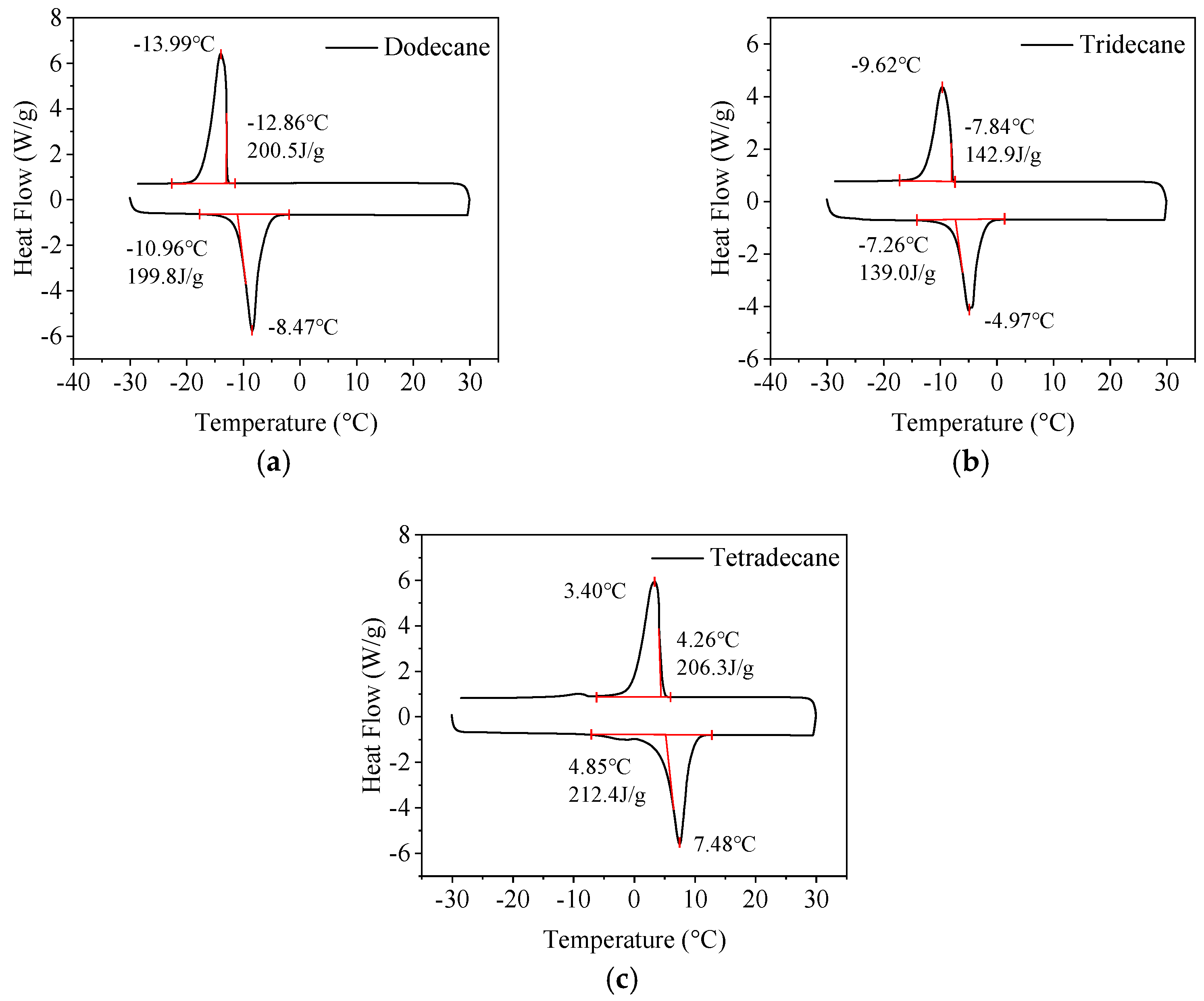
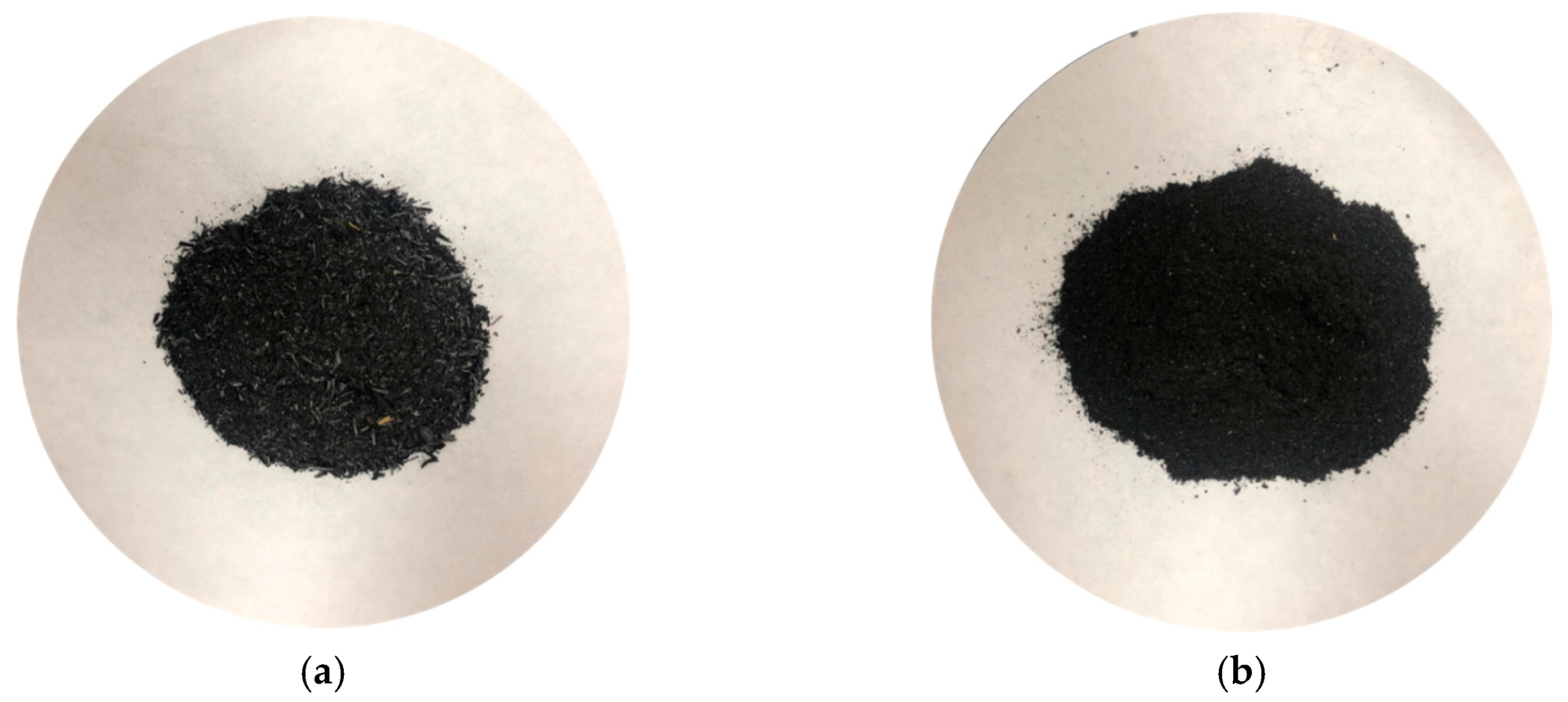
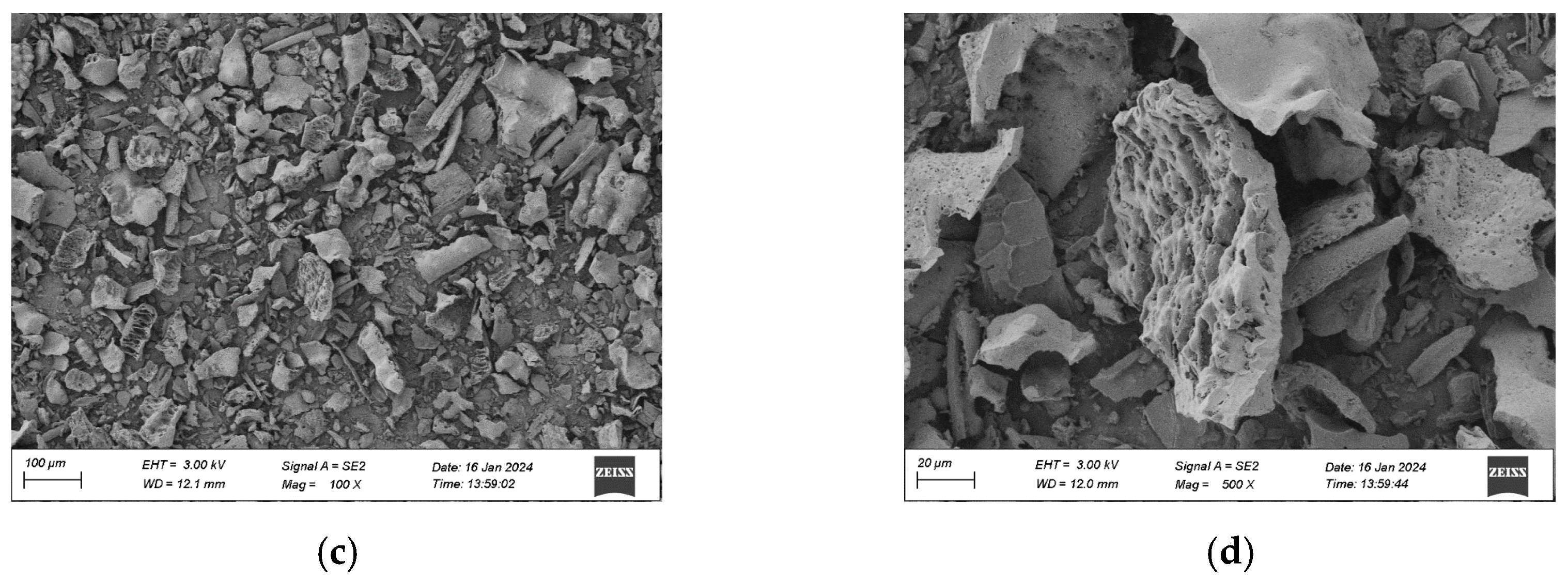
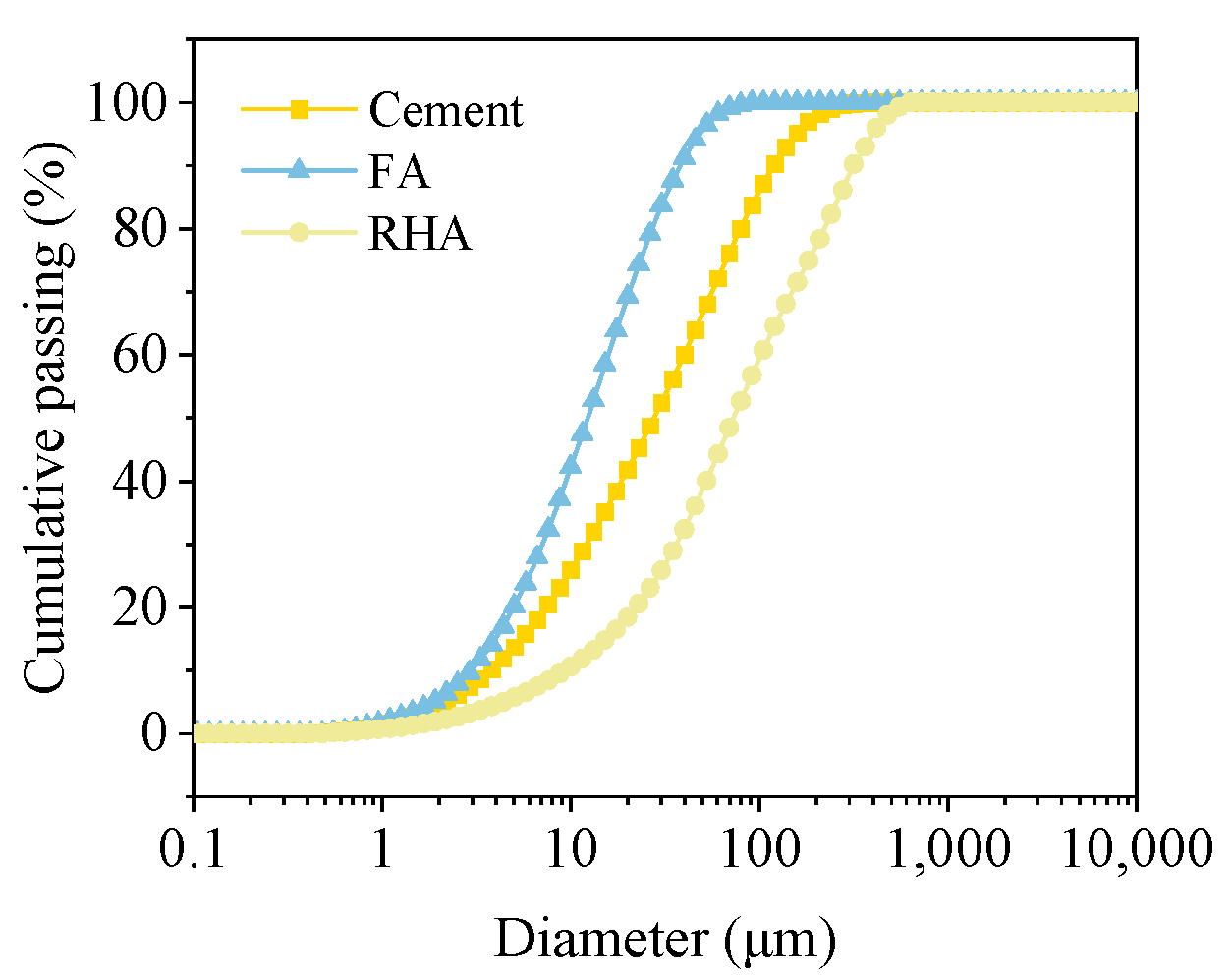
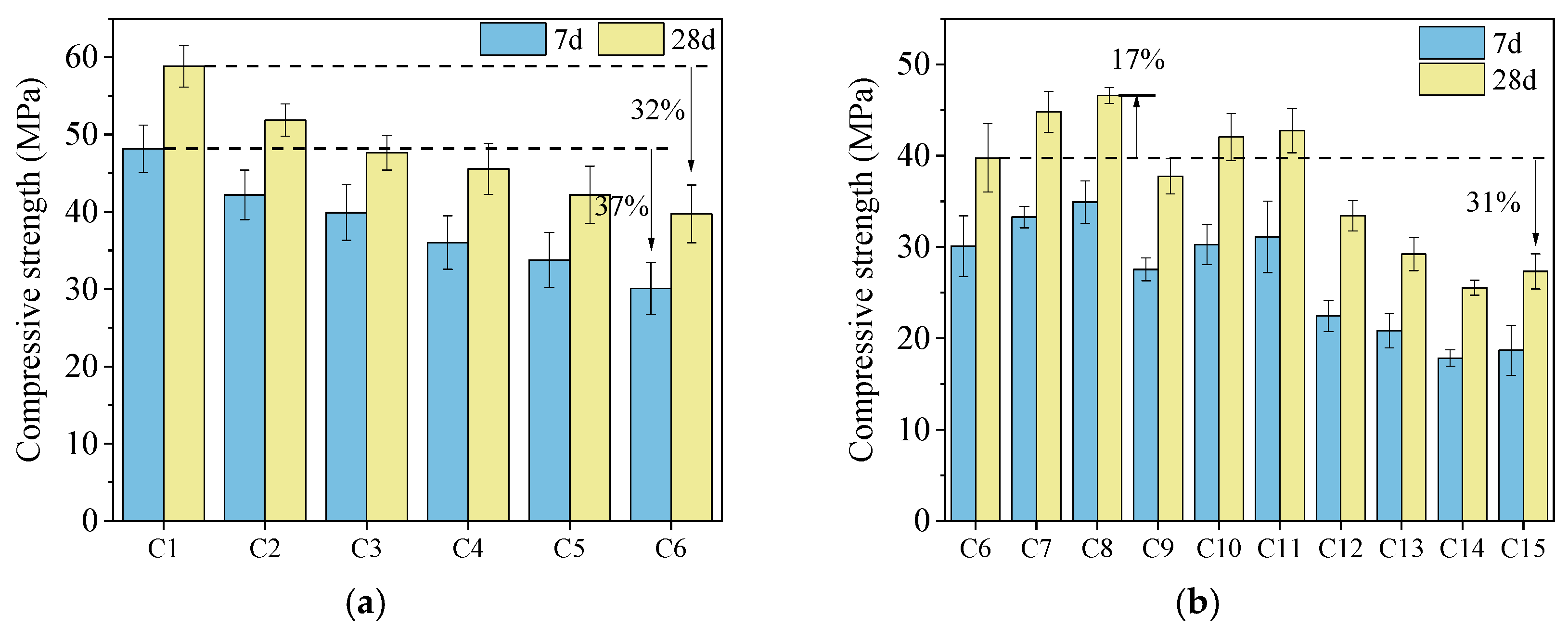
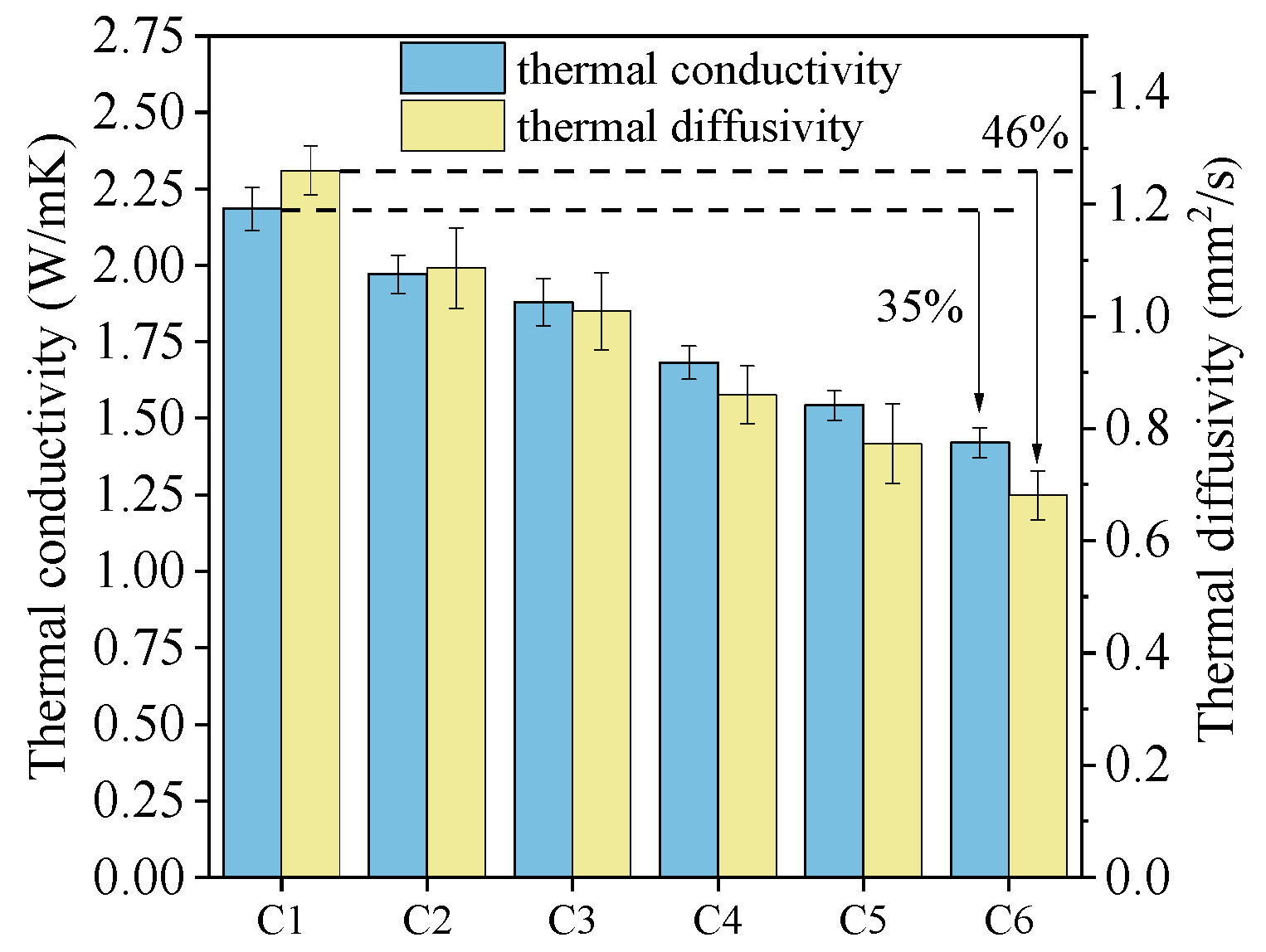
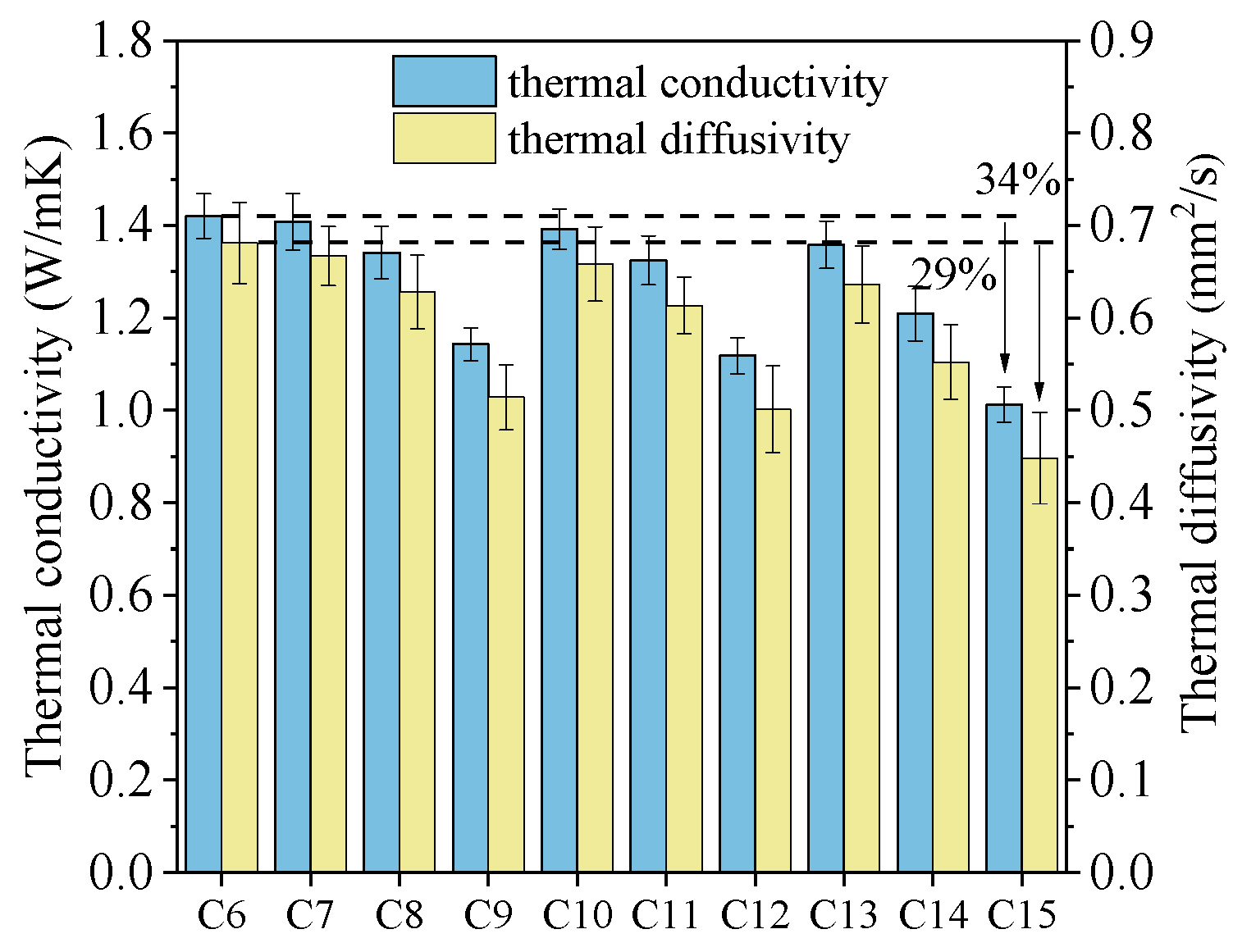
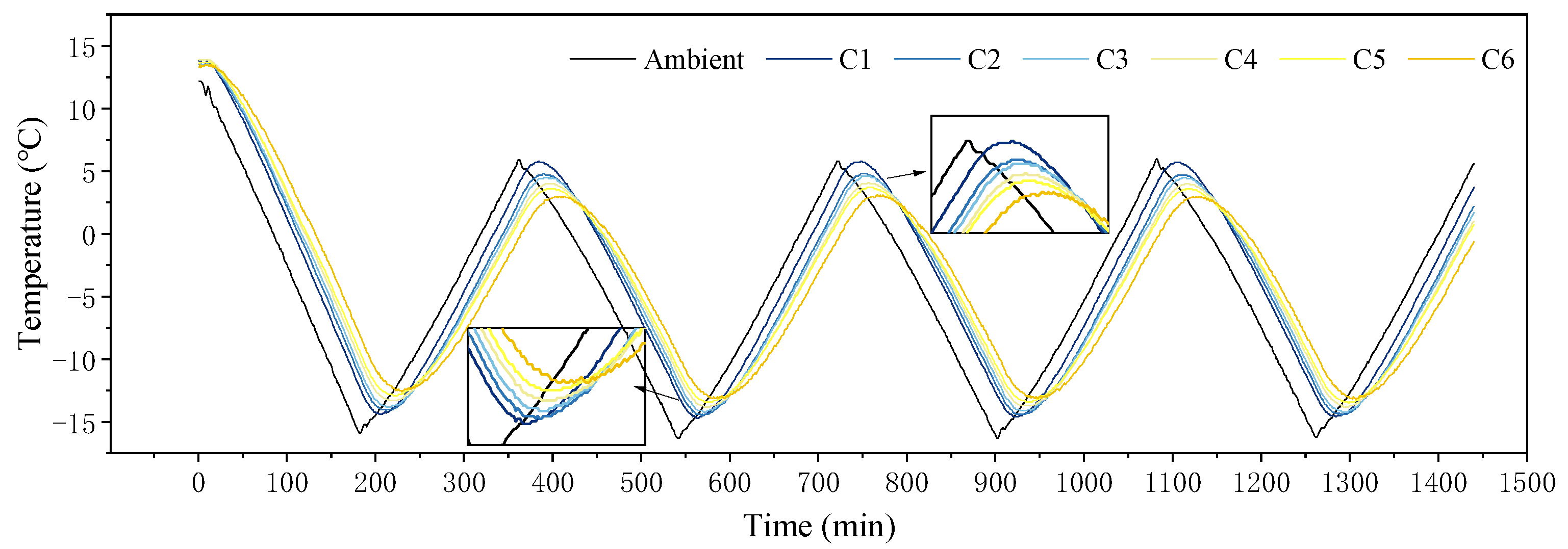
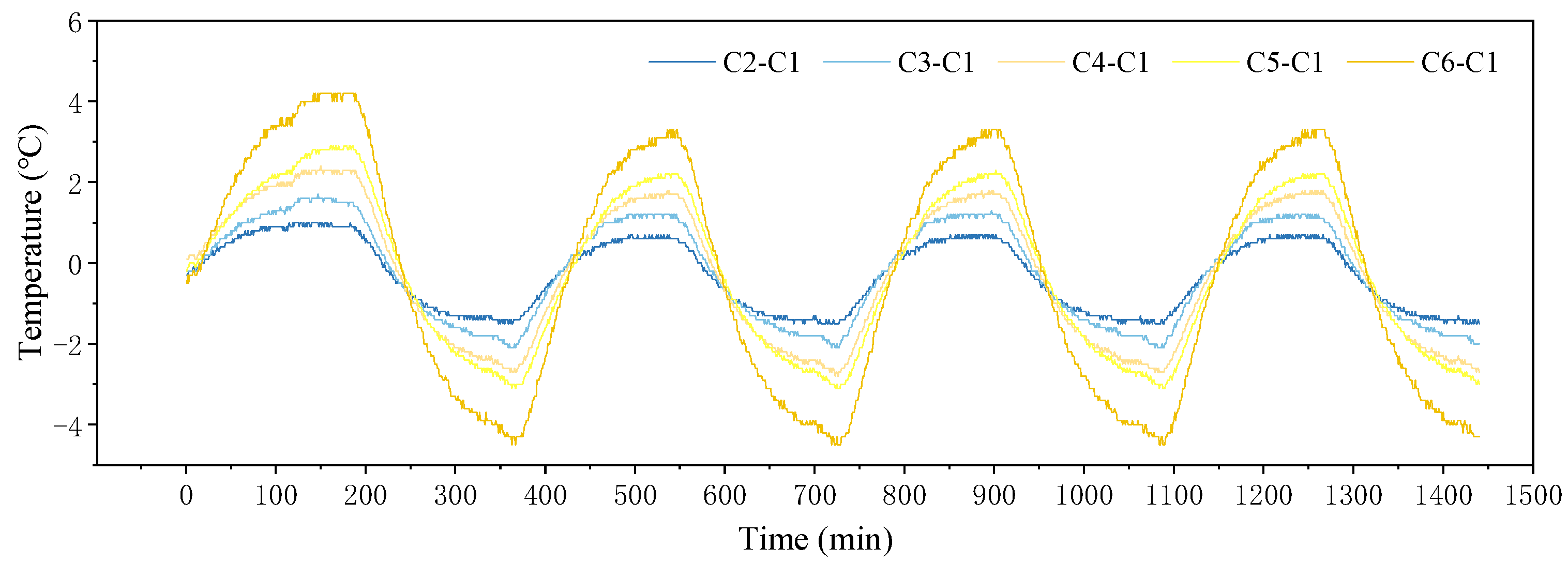
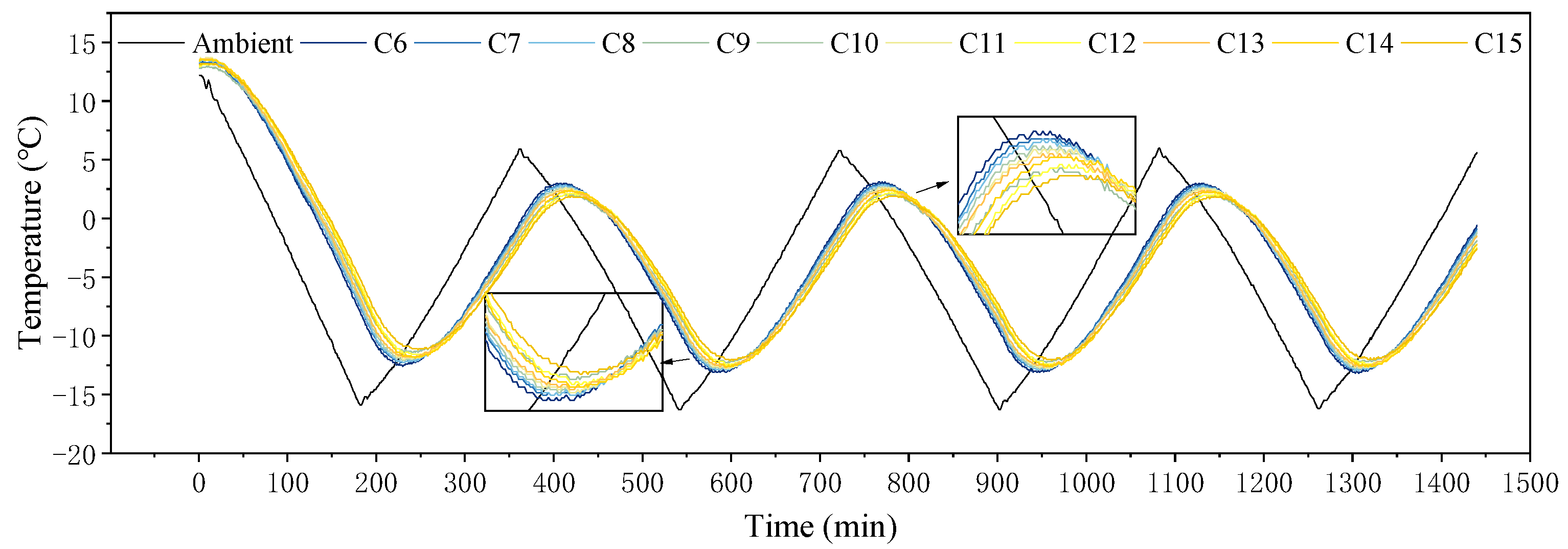
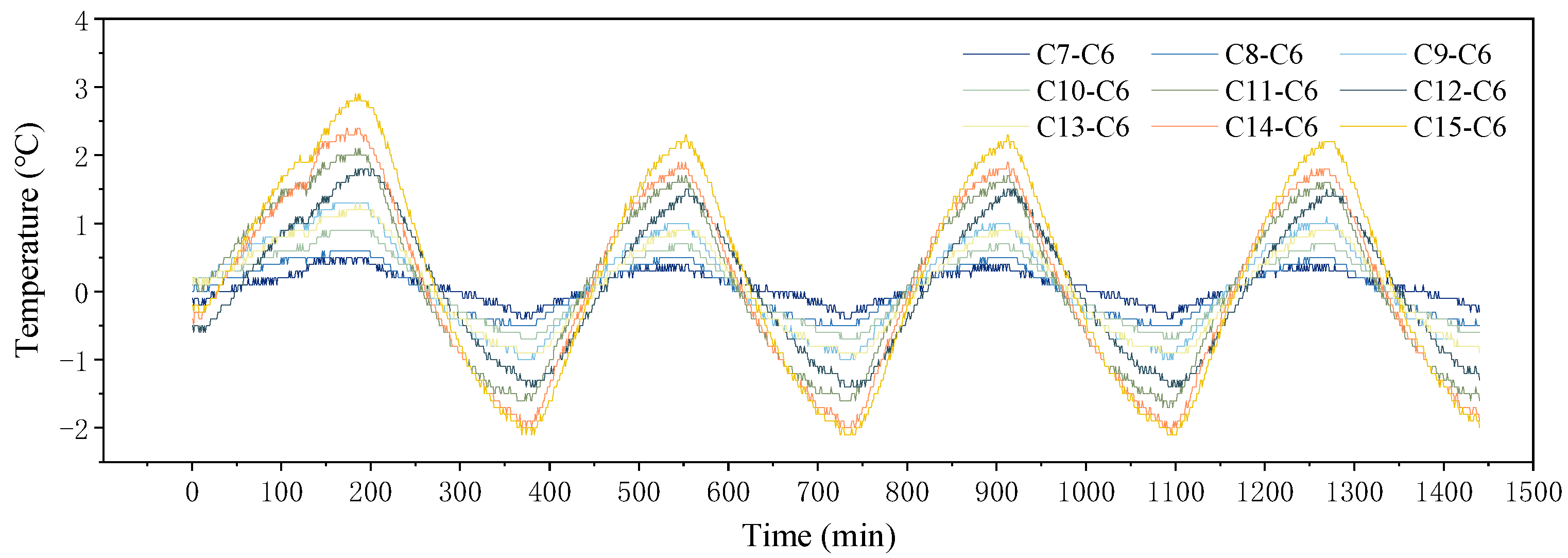
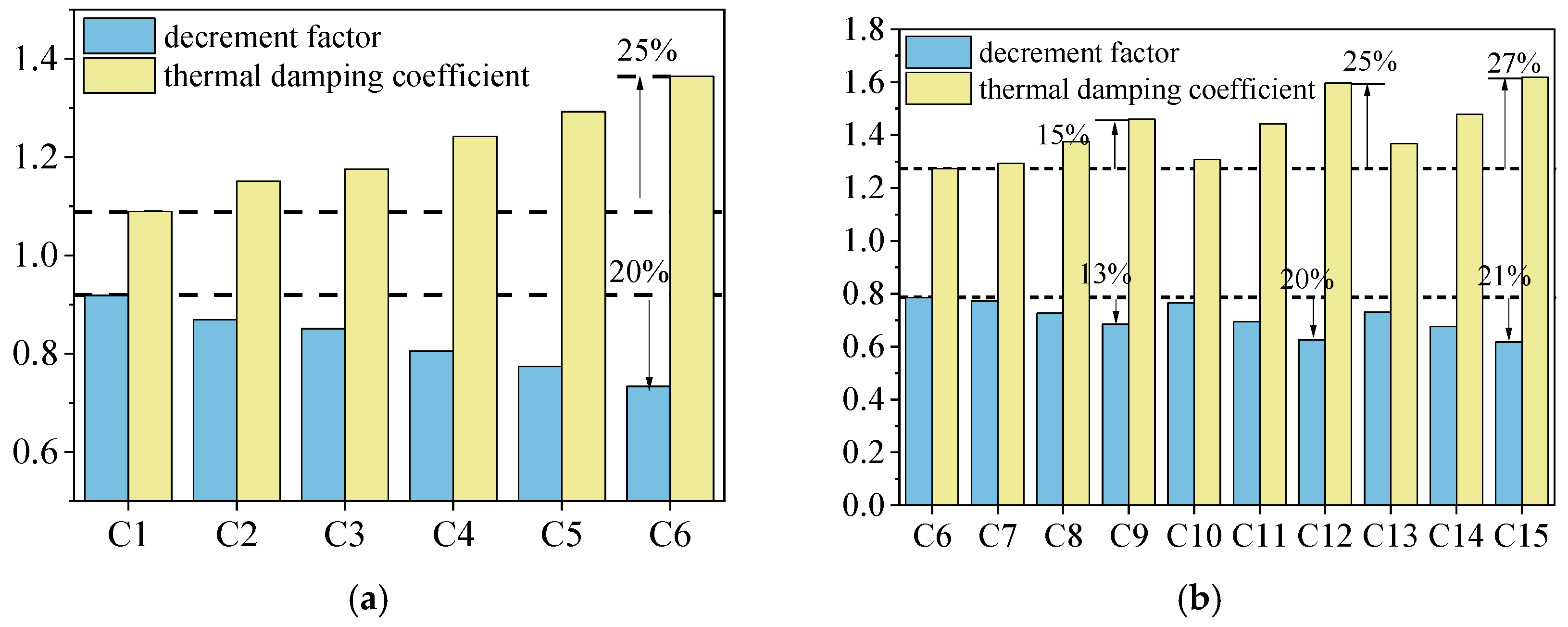
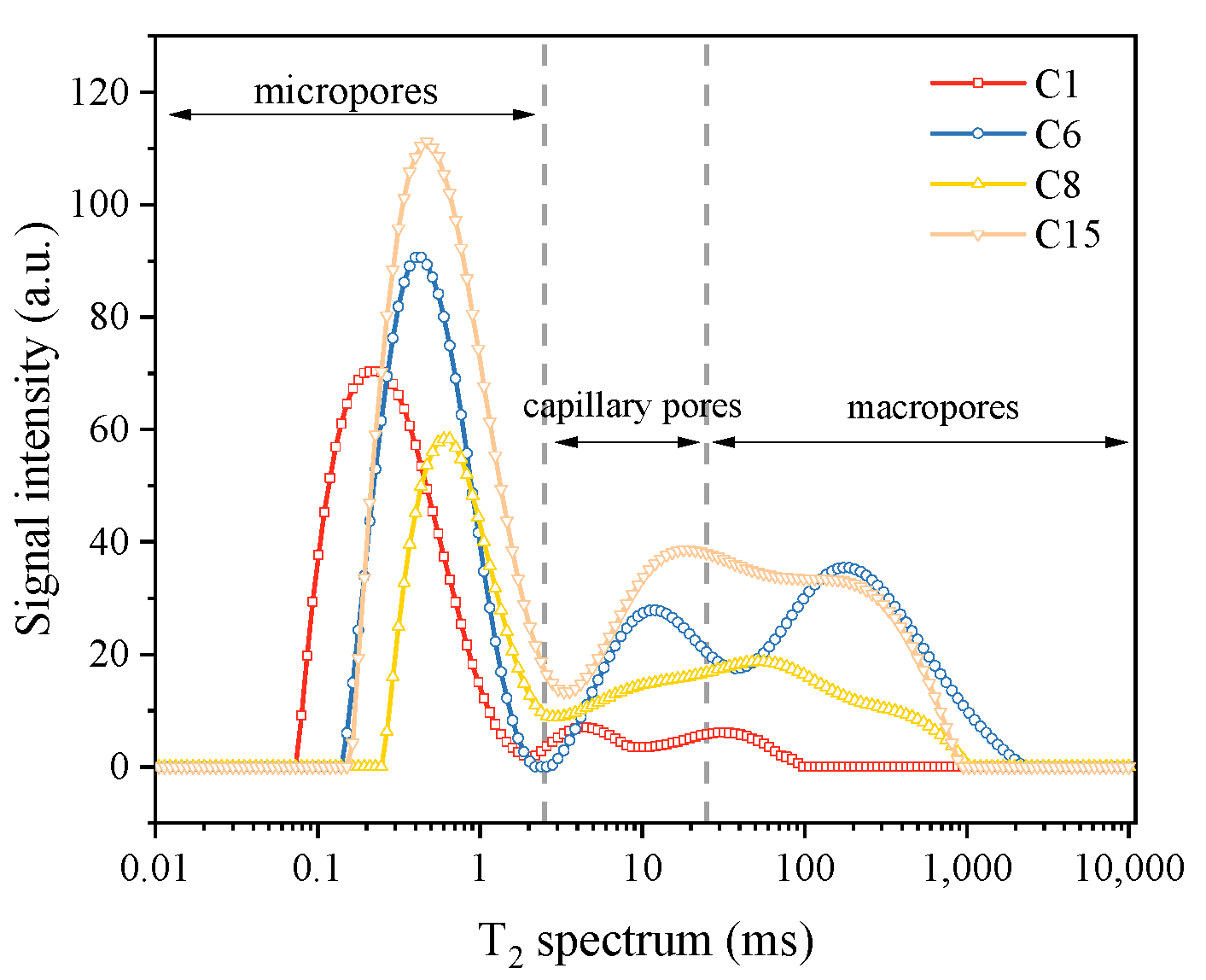
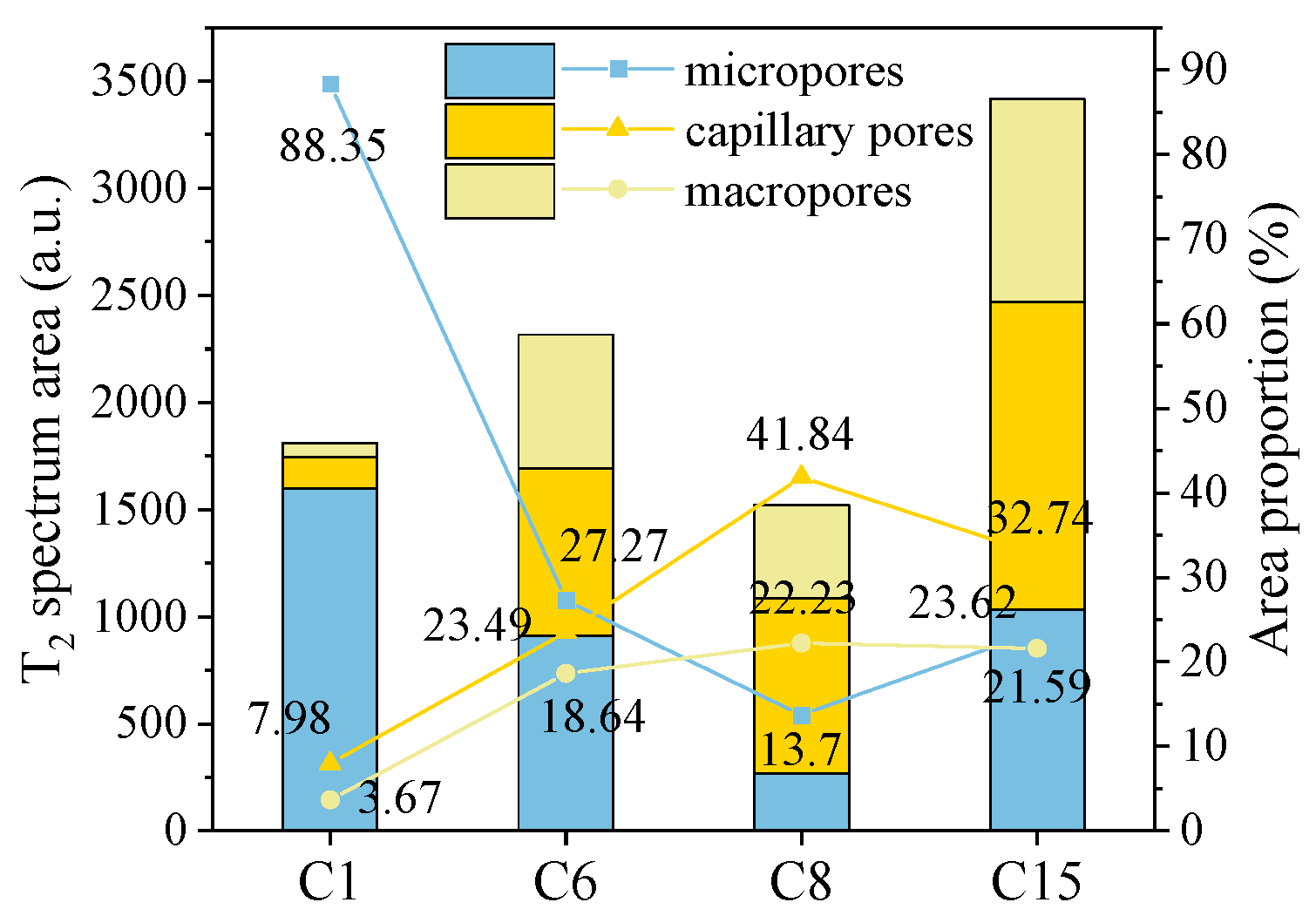
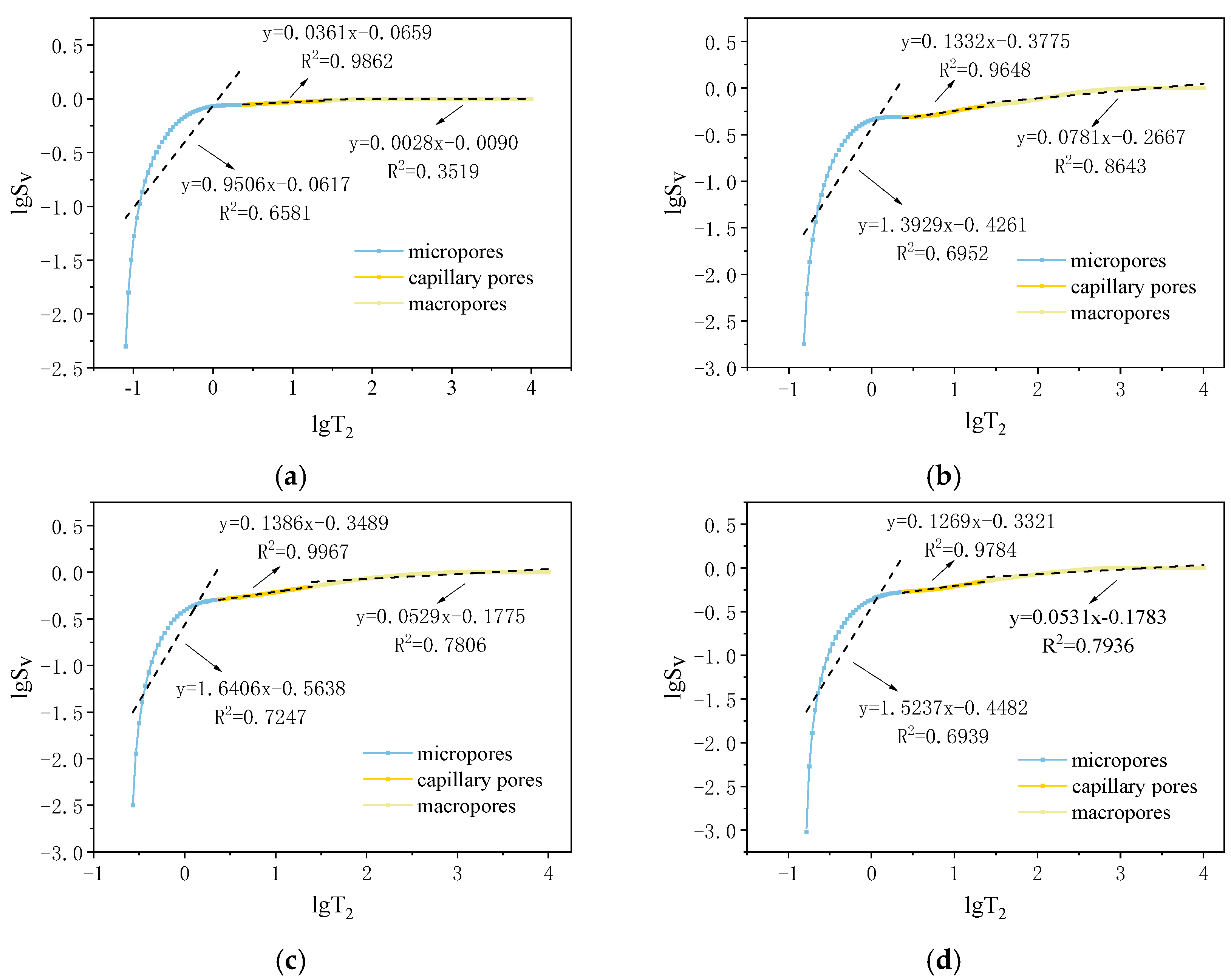
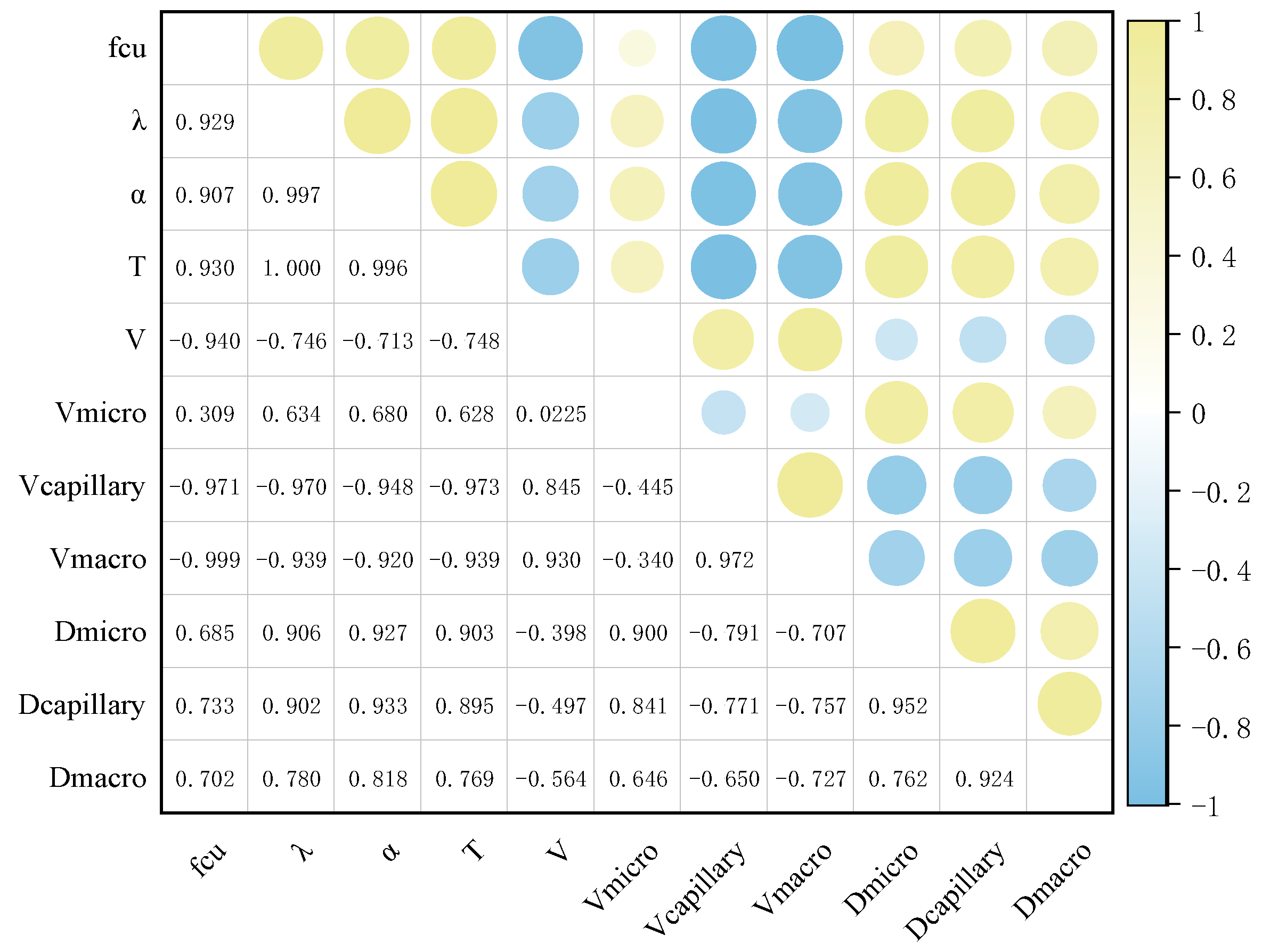

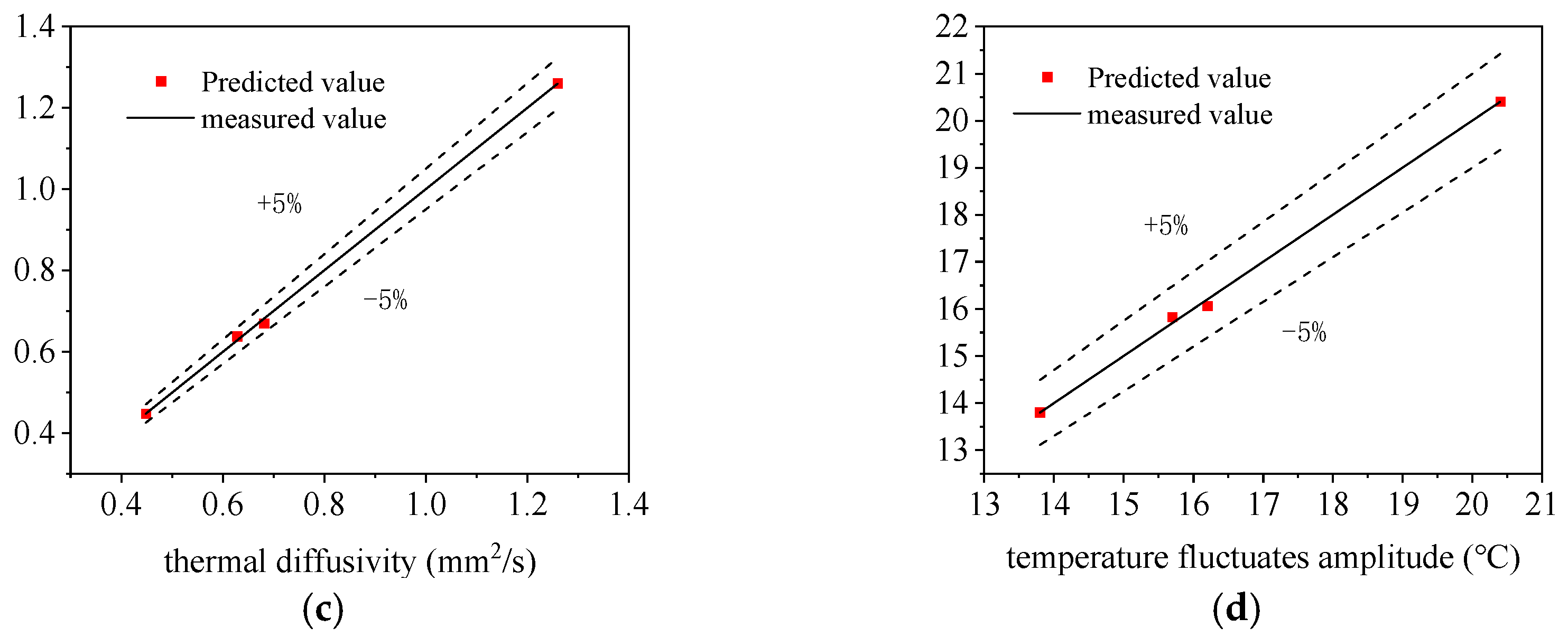
| Shale Ceramsite | PCM a | Epoxy Layer | Cement Layer |
|---|---|---|---|
| 59.62% | 10.31% | 9.10% | 20.97% |
| SiO2 | CaO | Al2O3 | Fe2O3 | MgO | SO3 | Na2O | K2O | TiO2 | MnO | P2O5 | |
|---|---|---|---|---|---|---|---|---|---|---|---|
| RHA | 86.82 | 1.70 | 0.47 | 1.71 | 0.61 | 0.55 | 0.20 | 5.12 | 0.05 | 0.45 | 1.89 |
| FA | 43.46 | 10.05 | 30.57 | 9.12 | 2.08 | 0.53 | 1.02 | 0.67 | 0.55 | 0.05 | 1.30 |
| Cement | 18.68 | 64.27 | 4.01 | 3.97 | 2.87 | 3.26 | 0.12 | 0.43 | 0.57 | 0.10 | 1.05 |
| Mix | Notes a | Cement | Sand | Gravel | PCM Aggregate | RHA | FA | Water |
|---|---|---|---|---|---|---|---|---|
| C1 | 0-0-0 | 550 | 652 | 1080 | 0 | 0 | 0 | 176 |
| C2 | 20-0-0 | 550 | 652 | 864 | 112 | 0 | 0 | 176 |
| C3 | 40-0-0 | 550 | 652 | 648 | 224 | 0 | 0 | 176 |
| C4 | 60-0-0 | 550 | 652 | 432 | 336 | 0 | 0 | 176 |
| C5 | 80-0-0 | 550 | 652 | 216 | 448 | 0 | 0 | 176 |
| C6 | 100-0-0 | 550 | 652 | 0 | 560 | 0 | 0 | 176 |
| C7 | 100-5-10 | 467.5 | 652 | 0 | 560 | 27.5 | 55 | 176 |
| C8 | 100-10-10 | 440 | 652 | 0 | 560 | 55 | 55 | 176 |
| C9 | 100-15-10 | 412.5 | 652 | 0 | 560 | 82.5 | 55 | 176 |
| C10 | 100-5-20 | 412.5 | 652 | 0 | 560 | 27.5 | 110 | 176 |
| C11 | 100-10-20 | 385 | 652 | 0 | 560 | 55 | 110 | 176 |
| C12 | 100-15-20 | 357.5 | 652 | 0 | 560 | 82.5 | 110 | 176 |
| C13 | 100-5-30 | 357.5 | 652 | 0 | 560 | 27.5 | 165 | 176 |
| C14 | 100-10-30 | 330 | 652 | 0 | 560 | 55 | 165 | 176 |
| C15 | 100-15-30 | 302.5 | 652 | 0 | 560 | 82.5 | 165 | 176 |
| Dmicro | K | R2 | Dcapillary | K | R2 | Dmacro | K | R2 | |
|---|---|---|---|---|---|---|---|---|---|
| c1 | 2.0494 | 0.00% | 0.6581 | 2.9639 | 0.00% | 0.9862 | 2.9972 | 0.00% | 0.3519 |
| c6 | 1.6071 | −21.58% | 0.6952 | 2.8668 | −3.28% | 0.9649 | 2.9219 | −2.51% | 0.8643 |
| c8 | 1.3594 | −15.41% | 0.7247 | 2.8614 | −0.19% | 0.9967 | 2.9471 | 0.86% | 0.7806 |
| c15 | 1.4763 | −8.14% | 0.6939 | 2.8732 | 0.22% | 0.9784 | 2.9469 | 0.86% | 0.7936 |
| fcu | λ | α | T | V | Vmicro | Vcapillary | Vmacro | Dmicro | Dcapillary | Dmacro | |
|---|---|---|---|---|---|---|---|---|---|---|---|
| C1 | 58 | 2.18 | 1.26 | 20.4 | 1811 | 1600 | 144 | 66 | 2.0494 | 2.9639 | 2.9972 |
| C6 | 39 | 1.42 | 0.68 | 16.2 | 3338 | 910 | 784 | 622 | 1.6071 | 2.8668 | 2.9219 |
| C8 | 46 | 1.34 | 0.63 | 15.7 | 1955 | 268 | 818 | 434 | 1.3594 | 2.8614 | 2.9471 |
| C15 | 27 | 1.01 | 0.45 | 13.8 | 4382 | 1034 | 1434 | 946 | 1.4763 | 2.8732 | 2.9469 |
| a | b | c | R2 | |
|---|---|---|---|---|
| fcu | 93.9631 | −0.0250 | −10.6988 | 0.9440 |
| λ | −9.2368 | −6.3687 × 10−4 | 3.8851 | 0.9991 |
| α | −9.3350 | −3.7723 × 10−4 | 3.5933 | 0.9994 |
| T | −39.7082 | −0.00368 | 20.4621 | 0.9985 |
Disclaimer/Publisher’s Note: The statements, opinions and data contained in all publications are solely those of the individual author(s) and contributor(s) and not of MDPI and/or the editor(s). MDPI and/or the editor(s) disclaim responsibility for any injury to people or property resulting from any ideas, methods, instructions or products referred to in the content. |
© 2025 by the authors. Licensee MDPI, Basel, Switzerland. This article is an open access article distributed under the terms and conditions of the Creative Commons Attribution (CC BY) license (https://creativecommons.org/licenses/by/4.0/).
Share and Cite
Zhang, M.; Gao, S.; Xu, J.; Wang, L.; Xu, M.; Ying, H. Sustainable Strategy to Reduce Winter Energy Consumption: Incorporating PCM Aggregates and Rice Husk Ash–Fly Ash Matrix into Concrete. Buildings 2025, 15, 2086. https://doi.org/10.3390/buildings15122086
Zhang M, Gao S, Xu J, Wang L, Xu M, Ying H. Sustainable Strategy to Reduce Winter Energy Consumption: Incorporating PCM Aggregates and Rice Husk Ash–Fly Ash Matrix into Concrete. Buildings. 2025; 15(12):2086. https://doi.org/10.3390/buildings15122086
Chicago/Turabian StyleZhang, Mingming, Shan Gao, Jin Xu, Lidong Wang, Mengyan Xu, and Honghao Ying. 2025. "Sustainable Strategy to Reduce Winter Energy Consumption: Incorporating PCM Aggregates and Rice Husk Ash–Fly Ash Matrix into Concrete" Buildings 15, no. 12: 2086. https://doi.org/10.3390/buildings15122086
APA StyleZhang, M., Gao, S., Xu, J., Wang, L., Xu, M., & Ying, H. (2025). Sustainable Strategy to Reduce Winter Energy Consumption: Incorporating PCM Aggregates and Rice Husk Ash–Fly Ash Matrix into Concrete. Buildings, 15(12), 2086. https://doi.org/10.3390/buildings15122086







